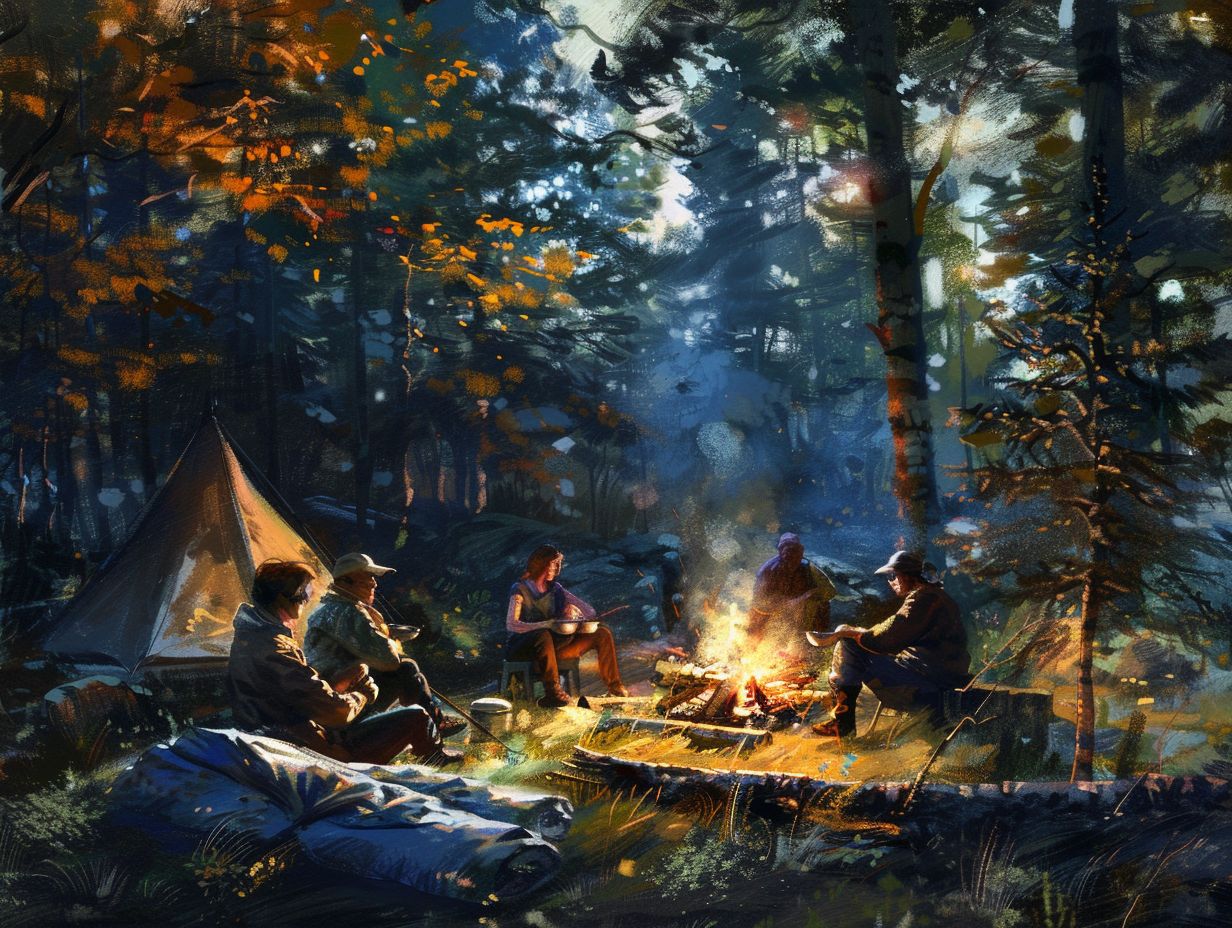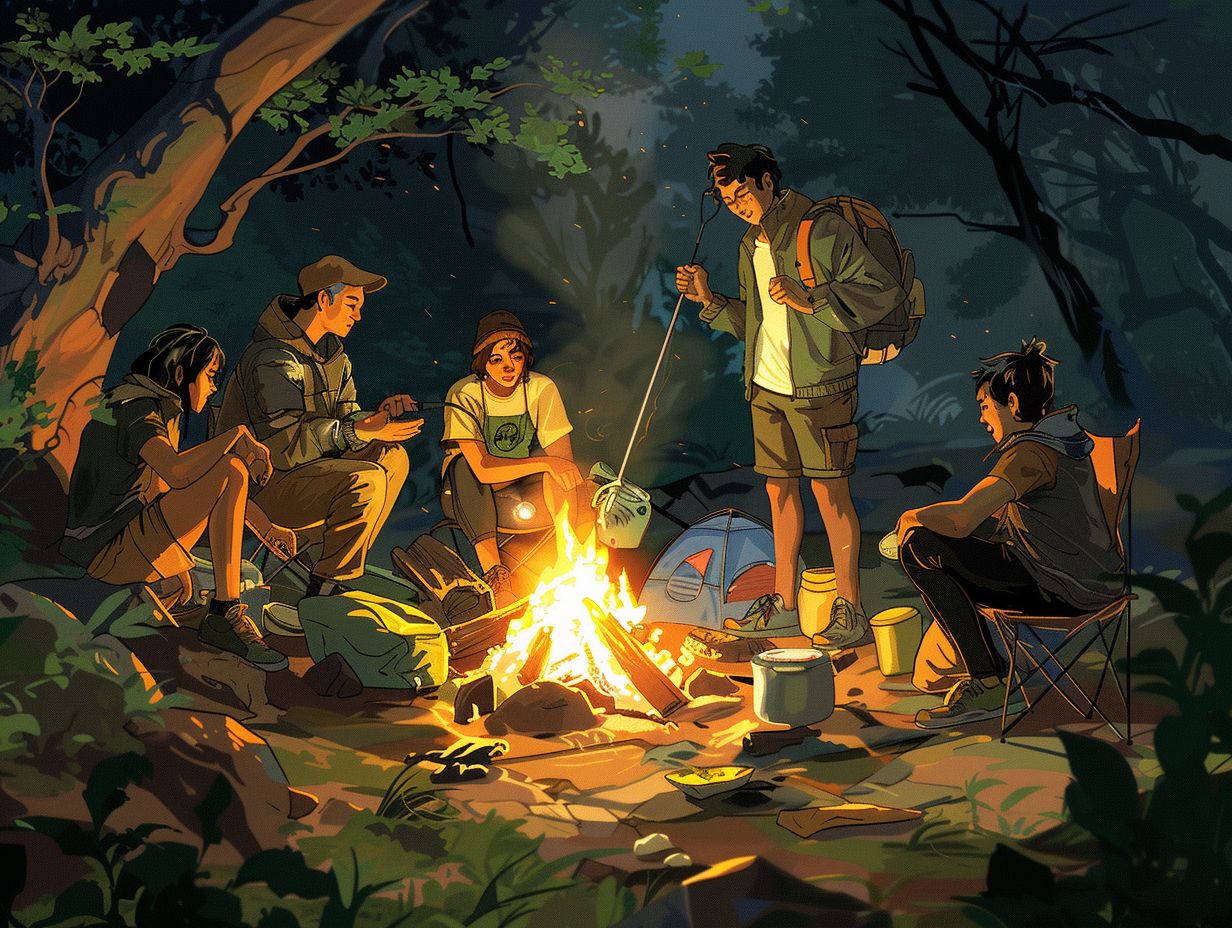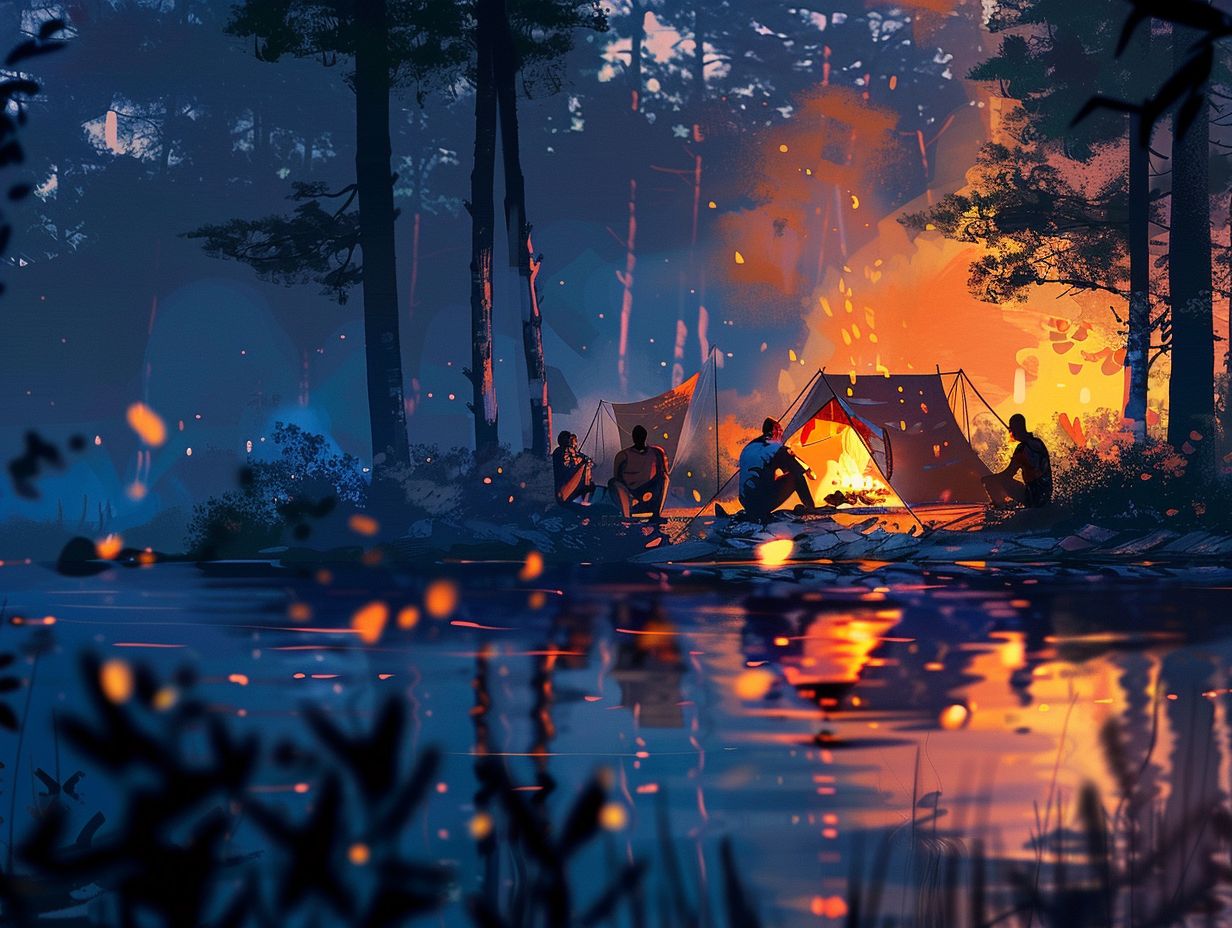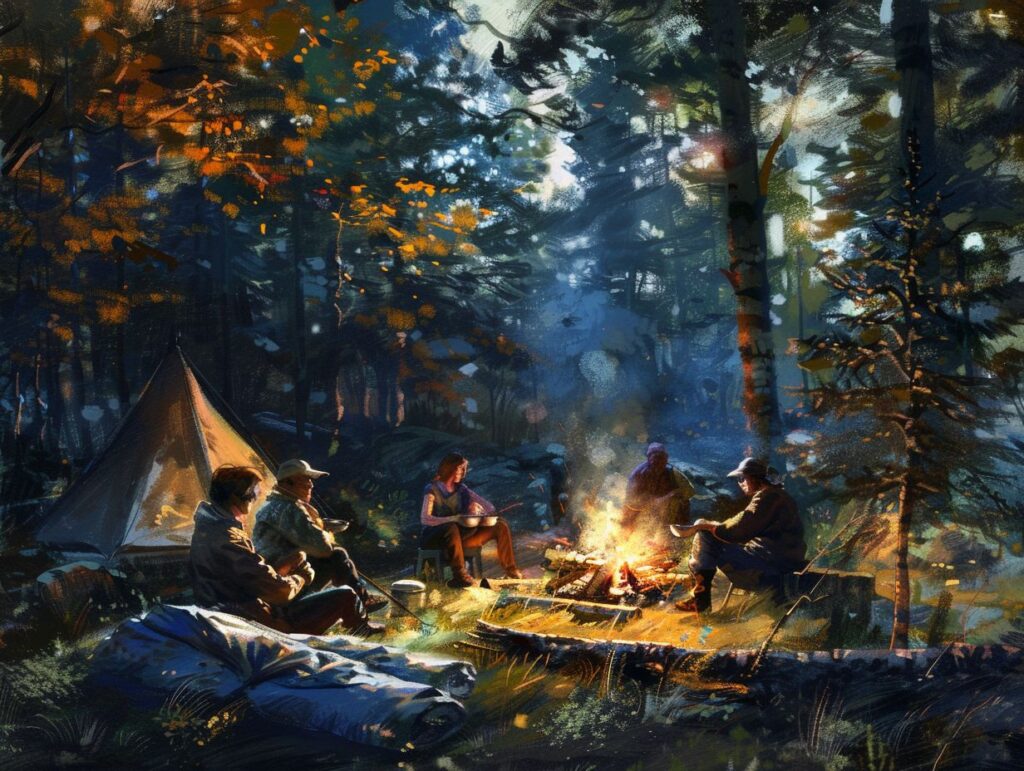Are you looking to up your camping game and add a new dimension to your outdoor cooking experience?
Discover the benefits of campfire cooking in this guide. Learn how cooking on a campfire can be fun, unique, save money, and enhance the camping atmosphere.
Explore essential tools for campfire cooking, easy recipes to try out, tips for successful cooking, and proper techniques to ensure a delicious meal every time.
Grab your cast iron skillet and let’s get cooking!
Key Takeaways:

- Campfire cooking provides a unique and enjoyable experience for campers, saving money and enhancing the camping atmosphere.
- Essential tools for campfire cooking include a campfire grill, cast iron skillet, and Dutch oven.
- Easy recipes for campfire cooking include foil packet meals, breakfast skillet, grilled vegetables, mac and cheese, and s’mores cones.
Why Cook on a Campfire?
Preparing meals over a campfire whilst engaged in a camping excursion not only offers a distinct experience but also presents a cost-effective solution and enriches the camping ambiance, rendering it an essential component of any outdoor endeavour.
1. Provides a Unique Experience
Cooking over a campfire offers a plethora of distinctive experiences that elevate ordinary meals to extraordinary campfire recipes. The act of preparing food over an open flame imbues a sense of uniqueness, from the crackling sounds of the fire to the smoky aroma that imparts a distinctive flavour to each dish.
The excitement of crafting culinary creations such as Dutch Oven Cinnamon Rolls or Chicken Pineapple Kebabs amidst the serenity of nature enhances the overall camping experience.
These gastronomic escapades not only satiate one’s appetite but also cultivate enduring memories shared among companions around the campfire. This communal dining experience with loved ones not only enhances the enjoyment of the camping trip but also contributes to creating unforgettable moments.
2. Saves Money
One advantageous aspect of cooking over a campfire is its potential for cost savings during a camping trip, as it reduces dependence on expensive dining options. Beyond financial considerations, the preparation of budget-friendly meals, such as foil parcel dinners or Cowboy Stew over a campfire, can add a fun and adventurous element to the outdoor experience.
The communal aspect of gathering around the fire, watching the cooking process, and enjoying the simplicity of a delicious homemade meal in the natural surroundings contributes to a unique atmosphere. These culinary choices not only provide financial value in the camping environment but also enhance the enjoyment of the meal and surroundings.
3. Enhances the Camping Atmosphere
The act of cooking over a campfire plays a significant role in enhancing the camping experience, creating a communal atmosphere and promoting relaxation through the warmth of the fire.
Gathering around the crackling flames, whether for preparing meals or engaging in leisure activities such as reading recipes on a Kindle app, fosters enduring memories and establishes a comfortable ambience that is inherent to the camping environment.
The subtle fragrance of toasting marshmallows, the mesmerising dance of the flames, and the shared merriment among companions amalgamate to form a profound connection that resonates within individuals.
These moments spent around the fire not only provide nourishment through delicious food but also offer emotional nourishment by fostering a sense of warmth and companionship.
What Are Some Easy Recipes for Campfire Cooking?
Numerous simple recipes for campfire cooking require minimal preparation and produce delightful results, including foil parcel meals, a camping breakfast frying pan, and s’mores cones.
1. Foil Packet Meals
Foil packet meals present a convenient and versatile option for campfire cooking, providing the opportunity to combine ingredients such as chicken and potatoes to create a flavoursome and efficient meal.
The process of preparing foil packet meals is simple yet impactful, involving the layering of selected ingredients onto a sheet of aluminium foil, followed by seasoning according to preference before sealing the foil to form a compact packet.
When assembling the ingredients, it is vital to position items that require longer cooking durations, such as root vegetables, in closer proximity to the heat source to ensure uniform cooking throughout.
Cooking over the campfire imparts a delicious smoky essence to the meal; it is advisable to intermittently rotate the packets to prevent burning or uneven cooking. Notable recipe ideas include shrimp and sausage foil packets or vegetarian alternatives featuring an array of colourful vegetables.
2. Camping Breakfast Skillet
A camping breakfast frying pan offers a delicious and convenient way to start your day with a hearty meal prepared directly over the campfire.
Common ingredients for a camping breakfast frying pan typically consist of diced potatoes, cooked sausage, eggs, and grated cheese. To create this satisfying dish, start by cooking the diced potatoes in a cast-iron frying pan until they achieve a golden brown, crispy texture. Add the cooked sausage, allowing the flavours to blend.
Then, break the eggs into the frying pan and gently scramble them with the other ingredients. Finish by generously sprinkling grated cheese over the top to achieve a delightful, gooey finish.
The attraction of this recipe lies in its flexibility – individuals are encouraged to add their favourite vegetables, herbs, or spices to customise the dish to their preferences.
3. Grilled Vegetable Skewers
Grilled vegetable skewers serve as a convenient and flavoursome campfire recipe that accentuates the intrinsic flavours of fresh vegetables.
Preparing grilled vegetable skewers over a campfire offers a simple process while imparting a rustic, smoky essence to the vegetables. The appeal of this dish lies in its adaptability, allowing the use of a diverse range of vegetables such as bell peppers, mushrooms, courgettes, cherry tomatoes, and onions.
The application of heat from the campfire initiates the caramelisation of the vegetables’ sugars, resulting in a delicious blend of sweet and savoury notes that are highly appealing. The contrast of charred exteriors and tender interiors introduces an engaging textural interplay, making each bite a satisfying sensory experience.
4. Campfire Mac and Cheese
Campfire mac and cheese is a delicious and creamy dish that is ideal for consumption while gathered around a campfire.
To prepare this savoury meal, the initial step involves cooking macaroni pasta in boiling water until it reaches an al dente texture. Simultaneously, butter is melted in a cast-iron skillet over the campfire. Subsequently, flour is added to form a roux, following which milk is gradually whisked in to produce a creamy base.
Grated cheddar cheese is then incorporated and stirred until it achieves a smooth and velvety consistency. For additional flavour enhancements, optional ingredients such as crispy bacon, diced jalapeños, or a dash of hot sauce can be introduced.
Upon completion of the pasta cooking process, it is combined with the cheese sauce and allowed to warm through over the fire. To achieve the desired cheesy texture, it is essential not to overcook the pasta as this may lead to clumping of the cheese.
Additionally, one may explore various toppings like breadcrumbs or fresh herbs to introduce texture variations and enhance the overall flavour profile.
5. S’mores Cones

S’mores cones offer a simple and delightful campfire dessert that introduces a playful variation to the traditional s’mores treat.
To create s’mores cones, one should begin by filling sugar cones with a mixture of miniature marshmallows, chocolate chips, and graham cracker crumbs. The cones should then be wrapped in aluminium foil and positioned over the campfire, rotating periodically for approximately 5-10 minutes until the ingredients are melted and achieve a gooey consistency.
Utilising a Kindle app can grant access to a plethora of s’mores recipe variations featuring diverse fillings such as peanut butter cups, caramel, or even fruity additions like bananas or strawberries. Experimenting with novel s’mores cone combinations can infuse excitement into campfire gatherings and gratify the sweet cravings of all participants.
How to Properly Cook on a Campfire?
The correct preparation of meals over a campfire necessitates the proper construction of the fire, application of appropriate cooking methods, and adherence to food safety practices to guarantee the creation of delicious and safe dishes.
1. Build the Fire Correctly
The correct construction of a fire serves as the cornerstone of effective campfire cooking, guaranteeing the presence of a reliable heat source for culinary preparations. Various approaches can be employed in the construction of a campfire.
The teepee method involves arranging kindling and logs in a conical configuration to facilitate air circulation, ensuring a fast and efficient combustion process. Conversely, the log cabin technique involves stacking logs in a square layout, offering greater control over the fire and extending its duration.
To maintain consistent cooking temperatures, it is essential to periodically add fuel, adjust the positioning of the logs, and carefully monitor the flames. Following these methods allows individuals to enjoy delicious dishes prepared over a carefully tended campfire.
2. Use the Right Cooking Techniques
Employing appropriate cooking methods, such as grilling and utilising a Dutch oven, can significantly elevate the quality and diversity of meals prepared over a campfire.
Grilling food over a campfire is a widely favoured technique that infuses meats and vegetables with a delicious smoky essence. To perfect the art of grilling, it is imperative to ensure that the fire generates ample hot coals and that a sturdy grate is in place.
When utilising a Dutch oven for baking purposes, the oven should be preheated by situating coals both underneath and on the lid. It is essential to intermittently rotate the oven during the cooking process to ensure uniform heat distribution.
In the preparation of foil packets, it is crucial to tightly seal the ingredients within to preserve flavours and moisture. The incorporation of a diverse array of seasonings and ingredients enhances the culinary experience, resulting in truly appetising foil-packed meals.
3. Practice Food Safety
Ensuring food safety protocols are followed during campfire cooking is essential to mitigate the risk of foodborne illnesses and guarantee thorough cooking of dishes such as chicken.
An integral component of food safety is the strict maintenance of segregation between raw and cooked foods to prevent any possibility of cross-contamination. This necessitates the utilization of separate utensils and cutting boards for raw meats and foods that are ready-to-eat.
The proper cooking of meat, particularly poultry such as chicken, to the requisite internal temperature is fundamental in eliminating harmful bacteria. It is advised to employ a food thermometer to verify that chicken attains an internal temperature of 165°F (74°C).
Preserving cleanliness throughout the meal preparation process is imperative. This includes regular handwashing, disinfection of surfaces, and appropriate storage of food items to forestall any instances of spoilage.
What Are Some Tips for Successful Campfire Cooking?
To ensure a successful campfire cooking experience, meticulous planning, utilisation of seasonal ingredients, and exploration of diverse flavours are imperative in crafting unforgettable meals.
1. Plan Ahead and Prep Ingredients
It is advisable to engage in advance planning and prepare ingredients prior to embarking on a camping trip, as doing so can enhance efficiency and enjoyment during campfire cooking activities.
Ahead of commencing the outdoor excursion, it is prudent to organise ingredients for each meal into distinct containers or resealable bags. The act of labelling these containers can facilitate swift access to necessary items at the campsite. Furthermore, pre-cutting vegetables, marinating proteins, and pre-measuring spices and seasonings can effectively streamline the cooking process.
Certain food items such as chilli, stir-fry, or skewers can greatly benefit from preparatory measures, as the amalgamation of flavours tends to intensify when ingredients have been given the opportunity to blend. Additionally, it is crucial to ensure that perishable items are stored in a cooler with ice packs to uphold their freshness throughout the camping trip.
2. Use Seasonal Ingredients

Utilising seasonal ingredients in campfire cooking not only enhances the flavour profile of meals but also contributes to local producers and ensures optimal freshness.
By integrating fresh, seasonal produce into campfire recipes, individuals align themselves with the natural cycles of the environment and celebrate the abundance of each season.
Whether incorporating juicy summer tomatoes into a vibrant salsa or grilling autumn squash with aromatic spices, the versatility of seasonal ingredients introduces depth and variety to the outdoor dining experience.
Opting for local sourcing not only minimises environmental impact but also fosters community connections and supports small-scale farmers.
Embracing the advantages of cooking with seasonal produce elevates the culinary experience to a level of enhanced taste and sustainability.
3. Experiment with Different Flavours
Exploring diverse flavours in campfire recipes has the potential to unveil delightful and unanticipated culinary revelations. Incorporating Chipotle seasoning into chicken tacos or imparting kebabs with a distinctive herb blend has the ability to enhance the outdoor cooking experience significantly.
The smoky nuances that evolve amidst the flames can harmonise with these assertive enhancements, resulting in a flavour profile that is sure to captivate the palate. Whether one gravitates towards a subtle spiciness or a pronounced zestiness, diving into an assortment of spices and herbs can unveil a realm of culinary opportunities in the context of campfire cooking.
Frequently Asked Questions
What is A Guide to Campfire Cooking?
A Guide to Campfire Cooking is a comprehensive guide that provides easy and delicious recipes for campers to prepare and enjoy on their camping trips. It includes a variety of dishes that can be cooked over a campfire, making it a perfect resource for outdoor cooking.
Why is campfire cooking a great option for campers?
Campfire cooking is a great option for campers because it allows them to enjoy delicious, home-cooked meals while being surrounded by nature. It also eliminates the need for bulky and expensive cooking equipment, making it a convenient and budget-friendly option.
What are some easy recipes included in this guide?
This guide includes a variety of easy recipes, such as foil-wrapped potatoes, campfire chili, and s’mores dip. These recipes require minimal ingredients and can be prepared quickly, making them perfect for campers on the go.
Can these recipes be adjusted for dietary restrictions?
Yes, many of the recipes in this guide can be adjusted to accommodate dietary restrictions. For example, you can use gluten-free bread for campfire sandwiches or substitute tofu for meat in campfire skewers.
Do I need any special tools or equipment for campfire cooking?
No, you do not need any special tools or equipment for campfire cooking. Most of the recipes in this guide can be cooked using basic camping equipment, such as a campfire grill, cast iron skillet, or foil packets.
Are there any safety precautions I should take when cooking over a campfire?
Yes, it is important to follow safety precautions when cooking over a campfire. Make sure to always have a bucket of water nearby, use heat-resistant gloves, and supervise children while cooking. Also, be careful when handling hot coals and make sure to properly extinguish the fire before leaving the campsite.

